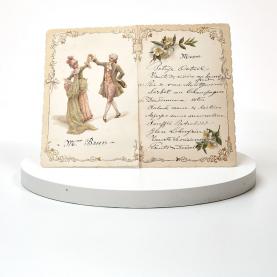Wedding food
While matrimony has not always been an affair of the heart, the wedding reception has always been a moment of excess. Despite the fact that, during Antiquity and the Middle Ages, laws limited spending, especially if related to weddings, people did not hide their wealth and the union between two families was sealed with a banquet. This shared meal constituted a marked contrast with everyday food thanks to the abundance of rich dishes, as flavoursome as they were expensive.
From a private contract to a declaration of love
Matrimony has not always been an affair of the heart. Until the 20th century, three pillars lay at the foundation of the institution of marriage: the transfer of property, women’s right to sexuality and the legitimation of children.
In classic Antiquity, the union between a young girl and her suitor was based on a simple private contract between the two families. In Greece, there was no engagement period. Weddings took place in winter, when no work was required in the fields. Under the Roman Empire, an engagement period became obligatory and it was forbidden for a wedding to take place on certain days, such as Lemuria, the Day of the Dead.
During the Middle Ages, in the 13th century, marriage became one of the sacraments of the Christian church and was forbidden during Lent. The union was considered as sacred and of divine intent with rules of fidelity and monogamy. It was also at that time, probably as a result of courtly love, that affection between the spouses started to emerge in the ecclesiastical message. The union thereby also became an affair of the heart. In Europe, the Reformation and later the French Revolution resulted in a new approach to the institution of marriage: The former brought an end to its sacred character, while the latter introduced the possibility of civil marriage. Great Britain legalised divorce in 1857 and France followed suit in 1884.
An abundance of food
The wedding reception was never overlooked, regardless of social class. It was the opportunity for the two families to seal the union by sharing food. Excess was therefore the order of the day.
During Antiquity and the Middle Ages in Europe, sumptuary laws maintained social order by limiting spending and ostentatious consumption, notably in the case of weddings. However, it would appear that nobody respected these restrictions. In Greek cities, the bride’s jewellery reflected the opulence of her family. The wedding banquet, to which thirty guests at the most were invited, comprised a rich array of meat and fish. Each family had a separate table. The banquet ended with the sesamous, a cake made from grilled sesame seeds and honey reserved for the bride and groom, while the guests shared the plakous made from flour, honey and goat’s cheese. During the Roman Empire, on the morning of the big day, the bride and groom made an offering of a cake made from spelt to Jupiter before being united “by water and by fire, by wheat and by sacred flour” (Melchior-Bonnet, Salles, 2010).
Banquets in the Middle Ages were devoid of any religious characteristics and were real shows. The nobility paid as much attention to the decoration of the room (tapestries, fountains) as they did to the choice of dishes and to the entremets served between courses, with the food considered as entertainment in itself. In less lavish banquets, there was already a culinary slant to the entremets, which frequently included wheat porridge and jellied fish. Sources say that, in 1458, for the wedding between the Duke of Burgundy, Charles the Bold, and the English Duchess Margaret of York, forty-eight dishes were served, including birds redressed to resemble the living animal as much as possible.
Bourgeois wedding banquets shortly before the French Revolution were described as staid and boring. In the countryside, however, a wedding was synonymous with a party! The meagre everyday meals were replaced, for one day, by pies, pâté, meat and cakes served to the guests by the groom himself. In the 19th century, there were few changes in the rural regions. The desserts and sweet dishes reflected the exceptional aspect of the meal and the contrast with everyday food. The French bourgeoisie discovered Antonin Carême’s croquembouche, a precursor to the pièce montée, a tall cone of profiteroles typically served at French weddings today.
Eggs and spoons as signs of affection
Europe’s rural societies traditionally showed affection through everyday objects. On Easter Monday in the Czech Republic, a young woman would give sixty painted eggs to a young man as a sign of her fondness. If he accepted, the suitor would plant a tree on the night of 1 May. In Italy and Austria, for example, decorated spoons are a traditional gift, symbolising food and fertility. It is not by chance that the expressions spooning in English or löffeln in German do not just mean ‘to feed with a spoon’, but also refer to a loving cuddle.
BOLOGNE, Jean-Claude, 2005. Histoire du mariage en Occident. Paris : Éditions Hachette.
DUMAS, Véronique, 2011. Les dragées. Historia. Novembre 2011. pp. 106-112.
MELCHIOR-BONNET, Sabine et SALLES, Catherine, 2010. Histoire du mariage. Paris : Éditions Robert Laffont.






